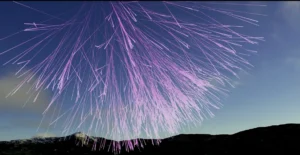The James Webb Space Telescope since its launch has shown us many marvelous planets and galaxies in the universe. This time James Webb discovered the two massive black hole collision just 740 million years after the Big Bang. This event is due to the ongoing merger of two galaxies and the supermassive black holes at their center. The system is known as ZS7.
Astronomers have discovered several supermassive black holes having millions to billions of times the mass of the Sun in many massive galaxies even in our Milky Way. These black holes play a major role in the formation of galaxies in which they reside in. However, the question of how these objects become so massive is still unanswered. The study of gargantuan black holes in the first billion years after the Big Bang shows that such a type of growth must have happened very fast and very early. Using the James Webb Space Telescope astronomers are now shedding new light on the growth of black holes in the early Universe.
How massive black holes are identified?
Massive black holes have distinctive spectrographic features due to actively accreting matter, allowing the astronomers to identify them. Only Webb can view these distance galaxies as there light signals are almost inaccessible from the ground.
Hannah Übler a lead author of the University of Cambridge in the United Kingdom explained:
“We found evidence for very dense gas with fast motions in the vicinity of the black hole, as well as hot and highly ionised gas illuminated by the energetic radiation typically produced by black holes in their accretion episodes,”
“Thanks to the unprecedented sharpness of its imaging capabilities, Webb also allowed our team to spatially separate the two black holes.”
The team of astronomers found that the two black holes have a mass 50 million times the mass of Sun.

Roberto Maiolino of the University of Cambridge and University College London in the United Kingdom explained:
“The mass of the other black hole is likely similar, although it is much harder to measure because this second black hole is buried in dense gas,”
Hannah Übler further explained that:
“Our findings suggest that merging is an important route through which black holes can rapidly grow, even at cosmic dawn,”
“Together with other Webb findings of active, massive black holes in the distant Universe, our results also show that massive black holes have been shaping the evolution of galaxies from the very beginning.”
According to the team, the merger of the two super massive black holes will generate gravitational waves.
European Space Agency upcoming mission LISA (Laser Interferometer Space Antenna) will be the next generation gravitational wave observatory and will be the first space-based observatory dedicated to studying gravitational waves.
LISA Lead Project Scientist Nora Luetzgendorf of the European Space Agency in the Netherlands said:
“Webb’s results are telling us that lighter systems detectable by LISA should be far more frequent than previously assumed,”
“It will most likely make us adjust our models for LISA rates in this mass range. This is just the tip of the iceberg.”
This merger of supermassive black hole was from the observations made by NIRSpec Integral Field Spectroscopy programme. They have also been awarded by a new Large Programme in Webb’s Cycle 3 of observations with a mission to study in detail the relationship between massive black holes and their host galaxies in the first billion years.
One of the important objective of this programme will be to systematically search for and characterise black hole mergers. This will give us the data of the rate at which black hole merging occurs at early cosmic events and will assess the role of merging in the early evolution of black holes and the rate at which gravitational waves are produced from the dawn of time.
Reference:








